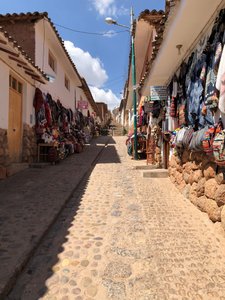Advertisement
Published: September 20th 2022

 Chinchero
Chinchero
Local goods. Another day of travel was ahead of us, leaving Cusco behind to transfer to Urubamba in the Sacred Valley.
We had two stops ahead of us: Chinchero and Ollantaytambo.
Our first stop was Chinchero, known to the Incas as the birthplace of the rainbow. This typical Andean village is a town well known for preserving ancient Inca customs and for making beautiful weavings with natural dyes. It is home to the Interpretation Center of Andean Textiles. Women in traditional costume will demonstrate how they produce the different colors for the wool they spin and weave.
Unfortunately, construction is progressing on an airport clearly visible from the old callejones, the alley like streets from ancient times. No doubt it will influence and change the current rustic charm of this ancient village.
Chinchero was built in the late 1400s by the Inca Tupac Yupanqui, who used it as a sort of country resort. In 1480 he ordered the construction of many aqueducts and terraces, many of them still in use today. The terraces for agricultural purposes were built in a way that extra rainwater flows in such an efficient way that it is difficult to imitate today.
In

 Chinchero
Chinchero
A demonstration of the ancient Andean tradition of making textiles from naturally dyed handwoven alpaca wool. The source for the vibrant colors are dyes that come from plants, minerals, and insects. 1540 Manco Capac ordered his followers to set fire to the town in order not to leave anything for the arriving conquistadores.
After an authentic Peruvian lunch where we could taste guinea pig if we chose to, attending a silver jewelry making workshop, a textile demonstration, and visiting a pottery workshop, we continued our journey to the impressive Inca fortress of Ollantaytambo, an ancient complex of temples and terraces towering high over the valley, the last stand of the Incas in their defense against the Spanish conquistadors.
The town of Ollantaytambo is the only Inca town in which the structures have been continuously inhabited since before the Conquest by local families who live according to the traditions and customs inherited from their ancestors.
We knew we were in for a memorable experience the moment we disembarked from our bus and looked up at the surrounding mountains. Ancient ruins seemed impossibly perched on the slopes, but even more impressive was the 400 foot tall stone profile of the face of Tunupa (Viracocha) on the side of Pinkuylluna mountain.
Although the town features restaurants, shops, and other amenities, the oldest section is aptly called a "Living Inca Museum."

 Chinchero
Chinchero
The local art of weaving, still using the same methods as in Inca times. We were fortunate enough to visit a local home before touring the ruins. Off one of those alley type streets, the family was gracious enough to invite us into their house, complete with ancestors skulls in a wall niche amongst other things. Never before have I felt so much like I had stepped through a window into history.
Ollantaytambo is located at an altitude of 9,160 feet above sea level. It was named after a warrior named Ollanta who fell in love with the daughter of the Sapa (high) Inca of the time. The love affair was forbidden, until events took place by which he saved one of the royal sons of the Sapa Inca. Another version says they eloped and founded the city but, since it was still named after him during Inca times, I think the original version is probably the real one.
The more formal and ancient name of the complex is believed to be Pacaritanpu, “House of the Dawn” or “House of Windows.”
During the Inca Empire, Ollantaytambo was the royal estate of Emperor Pachacuti who conquered the region and built the town and ceremonial center. After the arrival of the Spanish, the
fortress served as a temporary capital for Manco Inca, leader of the native resistance against the Spanish. In 1536, Manco Inca defeated a Spanish expedition, blocking their advance from a set of high terraces and flooding the plain.
The part of the hill facing the town contains the terraces of Pumatallis and a series of stairways dating back to the Inca period. One of the most challenging climbs of any Inca fortress. The Inca built the terraces at Ollantaytambo to a higher standard than common Inca agricultural terraces, with higher walls made of cut stones. This type of superior terraces are also found in other Inca royal estates.
The main structure of the whole sector is the Sun Temple at the top of the complex. Six huge rectangular stone blocks are located in one of the highest areas of the place, and it seems to be a construction that was left unfinished. The largest monolith is over 13 feet high and 6 1/2 feet wide.
It is mostly due to this construction that, similarly to other Inca ruins like Sacsayhuaman, comparing the incredible megalithic structures with other Inca ones has led archeologists to believe that the Inca

 Chinchero
Chinchero
Pucara bulls for good luck. tried to emulate pre-existing buildings, with the newer walls completely lacking the sophisticated style and architecture of the older structures.
Over the Pinkuylluna hill, the Inca built storehouses, or colcas, out of fieldstones. Their location at a higher altitude protected their contents longer. In addition, these colcas have ventilation systems. Grain would be poured in the windows on the uphill side of each building, and then emptied out through the downhill side window.
Personally, I found Ollantaytambo to be a fascinating Inca ruin, and I wish our schedule would have permitted a more in depth visit to the site.
Advertisement
Tot: 0.091s; Tpl: 0.013s; cc: 12; qc: 28; dbt: 0.058s; 1; m:domysql w:travelblog (10.17.0.13); sld: 1;
; mem: 1.1mb























